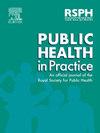Socio-economic health inequalities through the lens of social justice theory, an innovative perspective
IF 1.9
Q2 PUBLIC, ENVIRONMENTAL & OCCUPATIONAL HEALTH
引用次数: 0
Abstract
Background
Socioeconomic health inequalities, characterized by avoidable, systematic, and unfair differences in health between social groups based on socioeconomic disparities, persist in Western countries despite extensive efforts. This situation prompts a critical examination of current public health interventions. While individual-focused approaches emphasize behavioral strategies to address avoidable factors, and systems approaches target systematic causes, there remains a significant gap in addressing one crucial aspect of health inequalities: their inherent unfairness.
Study design
In this contribution, we conduct a theoretical exemplification.
Methods
Distributive, procedural, and recognitive justice theory has been employed as critical lens to analyze public health interventions and policies.
Results
Distributive justice focuses on the fairness of outcomes and is recognizable in the (re)distribution of resources such as food aid. However, if redistribution comes with stigma attached, it still fails to address fairness in full, which can hamper uptake. Procedural justice focuses on the fairness of the process leading up to certain outcomes. Stakeholder engagement in policy development is an example, but avoiding tokenism is key for truly reducing unfairness. Finally, recognitive justice emphasizes recognition, human dignity and equal social participation. It might be most elusive to ‘catch’ in policy but is also most crucial to address unfairness completely.
Conclusions
Integrating social justice theory into public health strategies promotes fairness and contributes to of the reduction of health inequalities.
社会经济卫生不平等现象通过社会正义理论的镜头,一个创新的视角
社会经济健康不平等的特征是基于社会经济差异的社会群体之间可避免的、系统的和不公平的健康差异,尽管做出了广泛的努力,但在西方国家仍然存在。这种情况促使人们对目前的公共卫生干预措施进行严格审查。虽然以个人为重点的方法强调解决可避免因素的行为策略,而系统方法则针对系统原因,但在解决卫生不平等的一个关键方面:其固有的不公平方面仍然存在重大差距。在这篇论文中,我们进行了一个理论例证。方法采用分配正义、程序正义和认知正义理论作为分析公共卫生干预措施和政策的关键视角。结果分配公正关注结果的公平性,在粮食援助等资源的(再)分配中得到认可。然而,如果再分配伴随着耻辱,它仍然不能完全解决公平问题,这可能会阻碍吸收。程序正义侧重于导致某些结果的过程的公平性。利益相关者参与政策制定就是一个例子,但避免表面现象是真正减少不公平的关键。最后,承认正义强调承认、人的尊严和平等的社会参与。在政策上“抓住”它可能是最难以捉摸的,但彻底解决不公平问题也是最关键的。结论将社会正义理论纳入公共卫生战略,促进公平,有助于减少卫生不平等现象。
本文章由计算机程序翻译,如有差异,请以英文原文为准。
求助全文
约1分钟内获得全文
求助全文

 求助内容:
求助内容: 应助结果提醒方式:
应助结果提醒方式:


